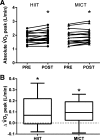Short-term high-intensity interval and moderate-intensity continuous training reduce leukocyte TLR4 in inactive adults at elevated risk of type 2 diabetes
- PMID: 26139217
- PMCID: PMC4556835
- DOI: 10.1152/japplphysiol.00334.2015
Short-term high-intensity interval and moderate-intensity continuous training reduce leukocyte TLR4 in inactive adults at elevated risk of type 2 diabetes
Abstract
Exercise can have anti-inflammatory effects in obesity, but the optimal type and intensity of exercise are not clear. This study compared short-term high-intensity interval training (HIIT) with moderate-intensity continuous training (MICT) in terms of improvement in cardiorespiratory fitness, markers of inflammation, and glucose control in previously inactive adults at elevated risk of developing type 2 diabetes. Thirty-nine inactive, overweight/obese adults (32 women) were randomly assigned to 10 sessions over 2 wk of progressive HIIT (n = 20, four to ten 1-min sessions at ∼90% peak heart rate, 1-min rest periods) or MICT (n = 19, 20-50 min at ∼65% peak heart rate). Before and 3 days after training, participants performed a peak O2 uptake test, and fasting blood samples were obtained. Both HIIT (1.8 ± 0.4 vs. 1.9 ± 0.4 l/min, pre vs. post) and MICT (1.8 ± 0.5 vs. 1.9 ± 0.5 l/min, pre vs. post) improved peak O2 uptake (P < 0.001) and lowered plasma fructosamine (P < 0.05). Toll-like receptor (TLR) 4 (TLR4) expression was reduced on lymphocytes and monocytes after both HIIT and MICT (P < 0.05) and on neutrophils after MICT (P < 0.01). TLR2 on lymphocytes was reduced after HIIT and MICT (P < 0.05). Plasma inflammatory cytokines were unchanged after training in both groups, but MICT led to a reduction in fasting plasma glucose (P < 0.05, 5.9 ± 1.0 vs. 5.6 ± 1.0 mmol/l, pre vs. post). Ten days of either HIIT or MICT can improve cardiorespiratory fitness and glucose control and lead to reductions in TLR2 and TLR4 expression. MICT, which involved a longer duration of exercise, may be superior for reducing fasting glucose.
Keywords: aerobic exercise; chronic inflammation; glucose control; high-intensity interval training; prediabetes.
Copyright © 2015 the American Physiological Society.
Figures



References
-
- Abbasi A, Hauth M, Walter M, Hudemann J, Wank V, Niess AM, Northoff H. Exhaustive exercise modifies different gene expression profiles and pathways in LPS-stimulated and un-stimulated whole blood cultures. Brain Behav Immun 39: 130–141, 2014. - PubMed
-
- Akira S, Hemmi H. Recognition of pathogen-associated molecular patterns by TLR family. Immunol Lett 85: 85–95, 2003. - PubMed
-
- Asai K, Hiki N, Mimura Y, Ogawa T, Unou K, Kaminishi M. Gender differences in cytokine secretion by human peripheral blood mononuclear cells: role of estrogen in modulating LPS-induced cytokine secretion in an ex vivo septic model. Shock 16: 340–343, 2001. - PubMed
-
- Avdiushko R, Hongo D, Lake-Bullock H, Kaplan A, Cohen D. IL-10 receptor dysfunction in macrophages during chronic inflammation. J Leukoc Biol 70: 624–632, 2001. - PubMed
Publication types
MeSH terms
Substances
LinkOut - more resources
Full Text Sources
Other Literature Sources
Medical

